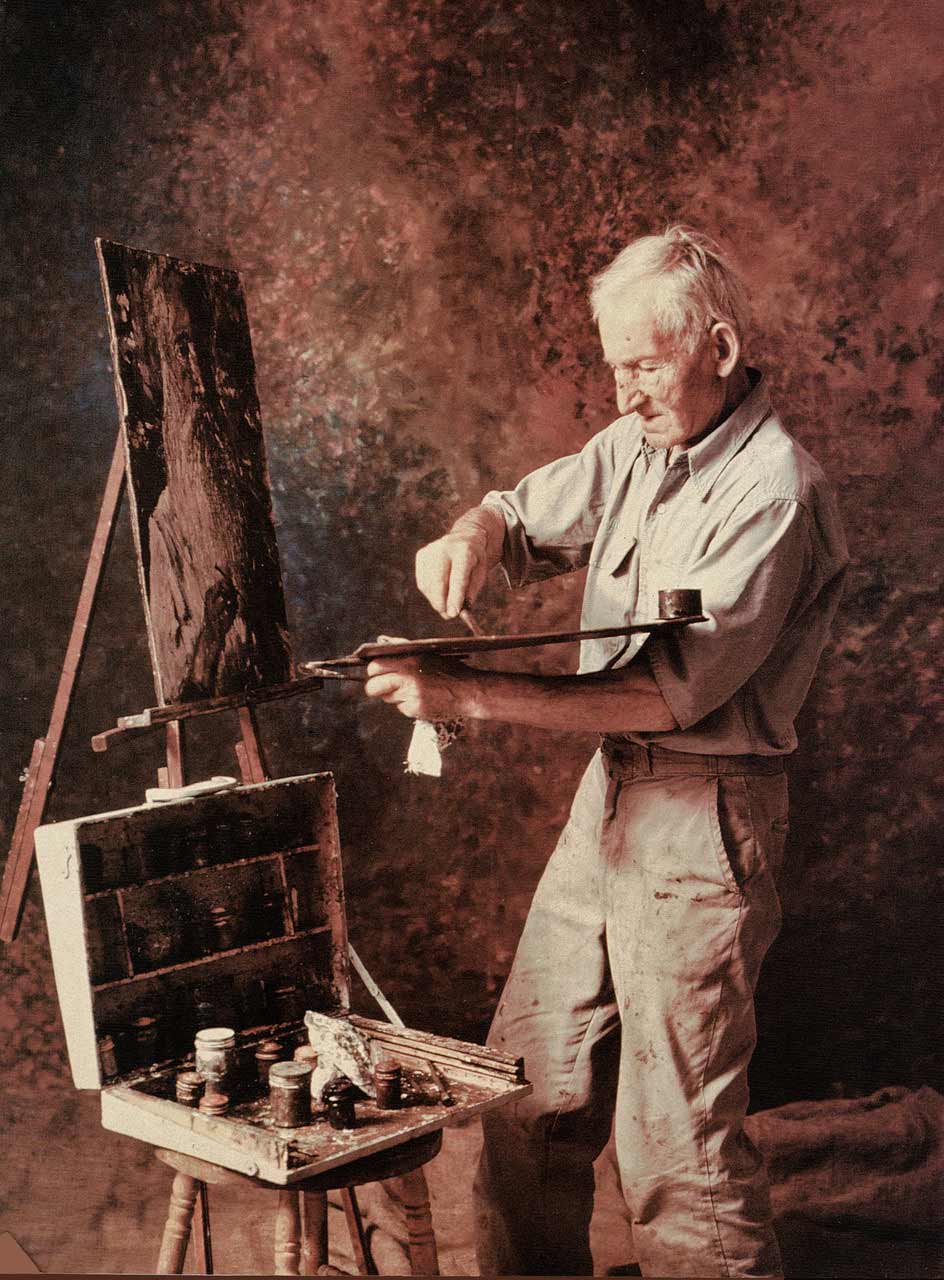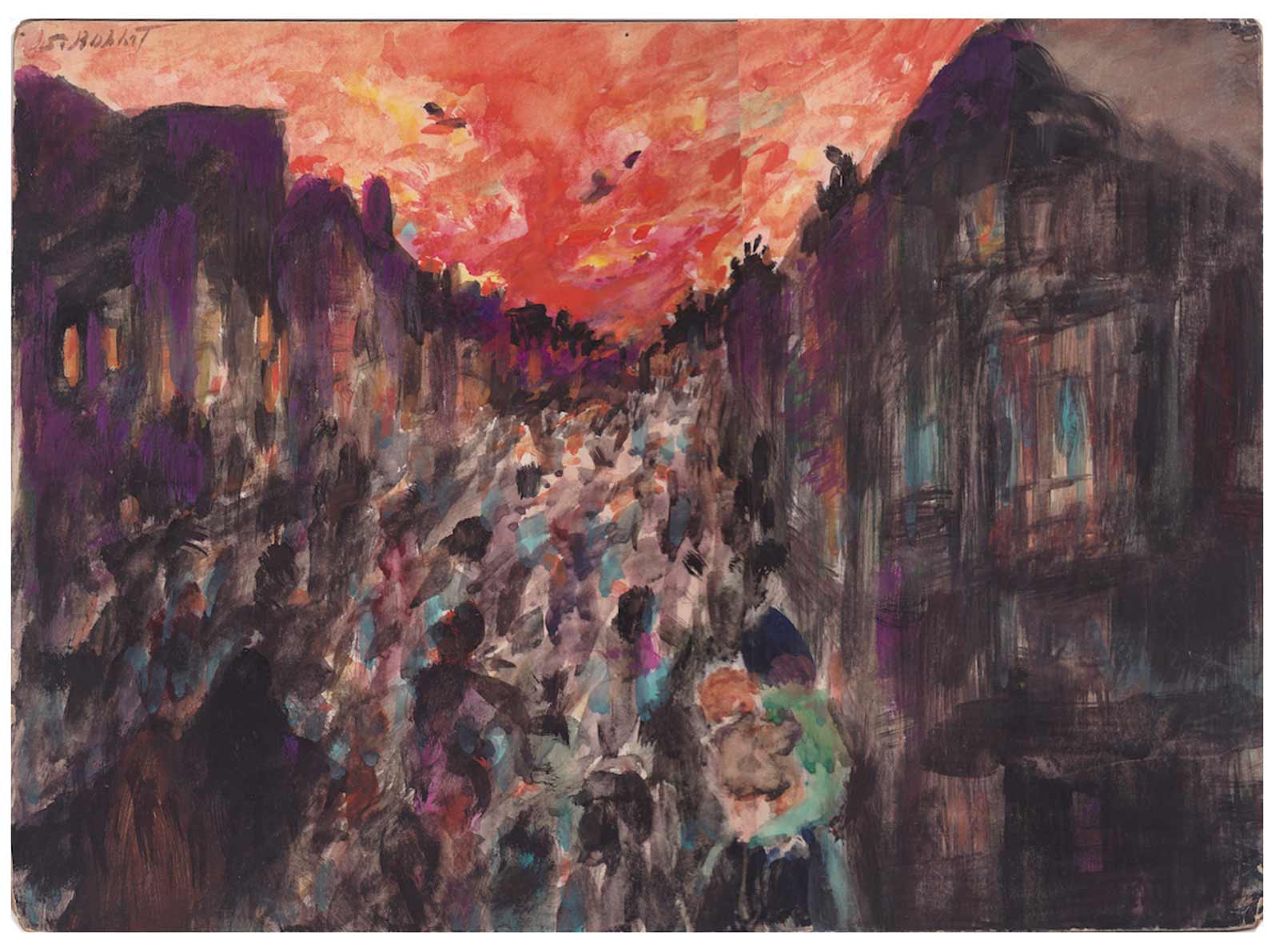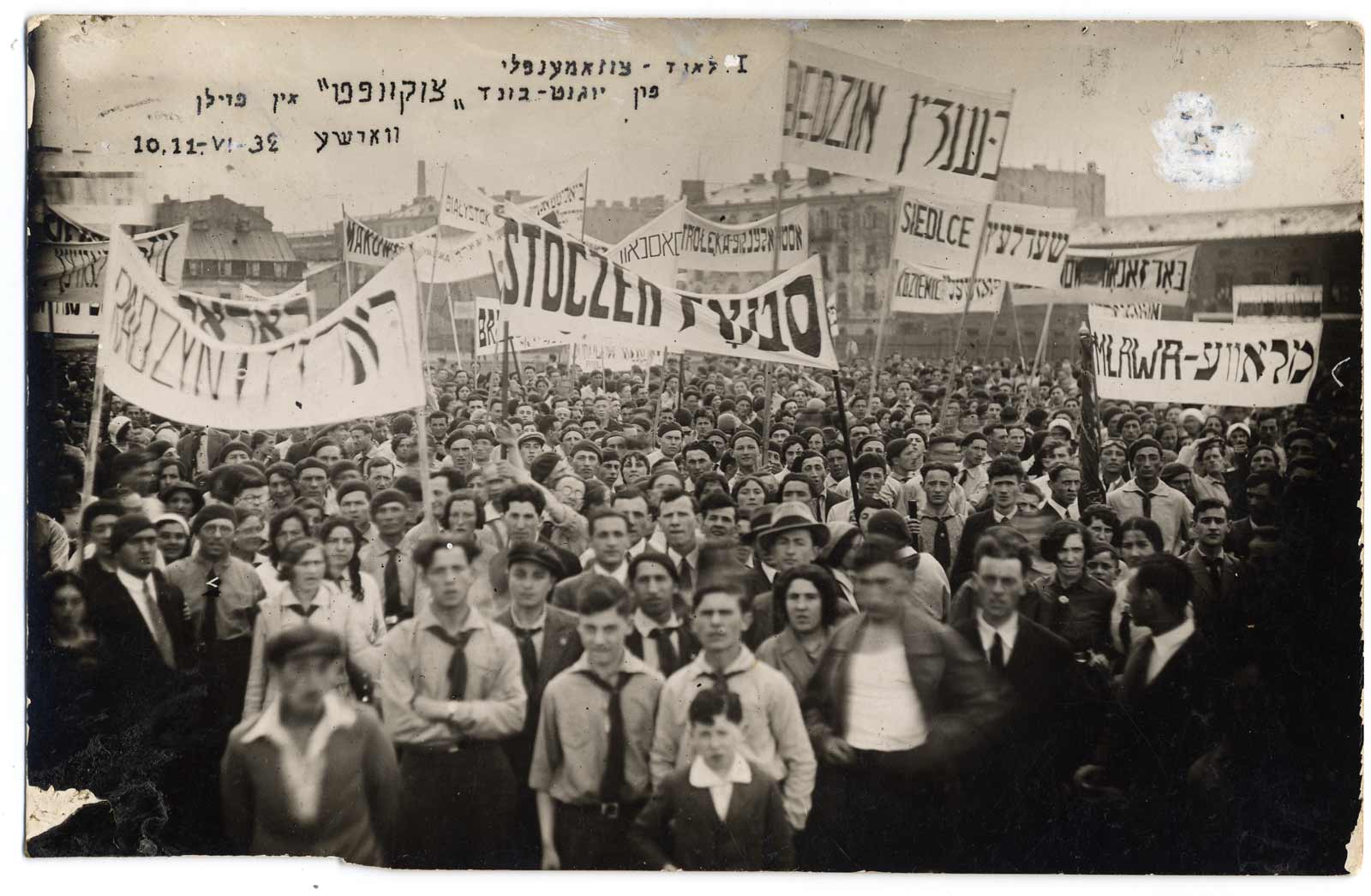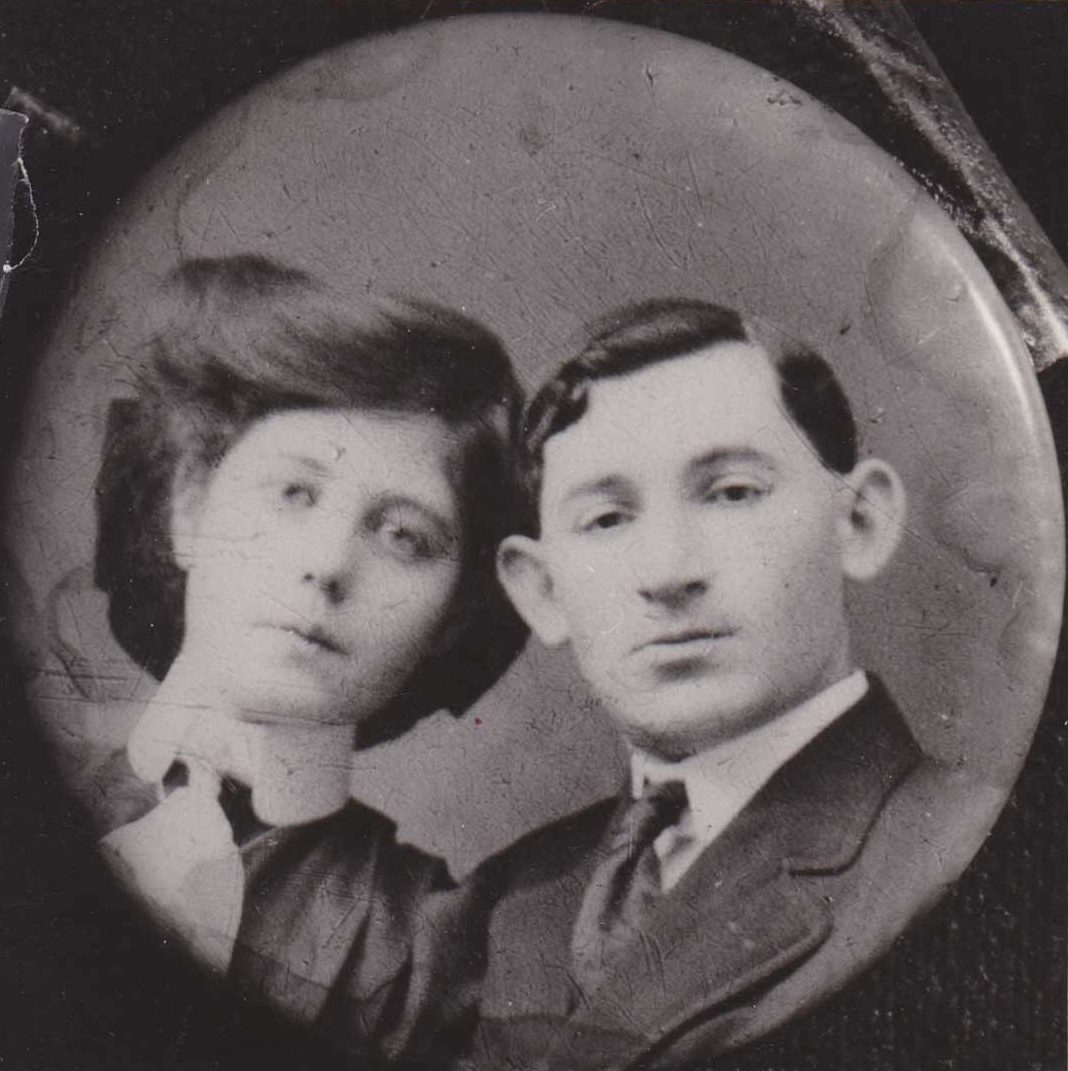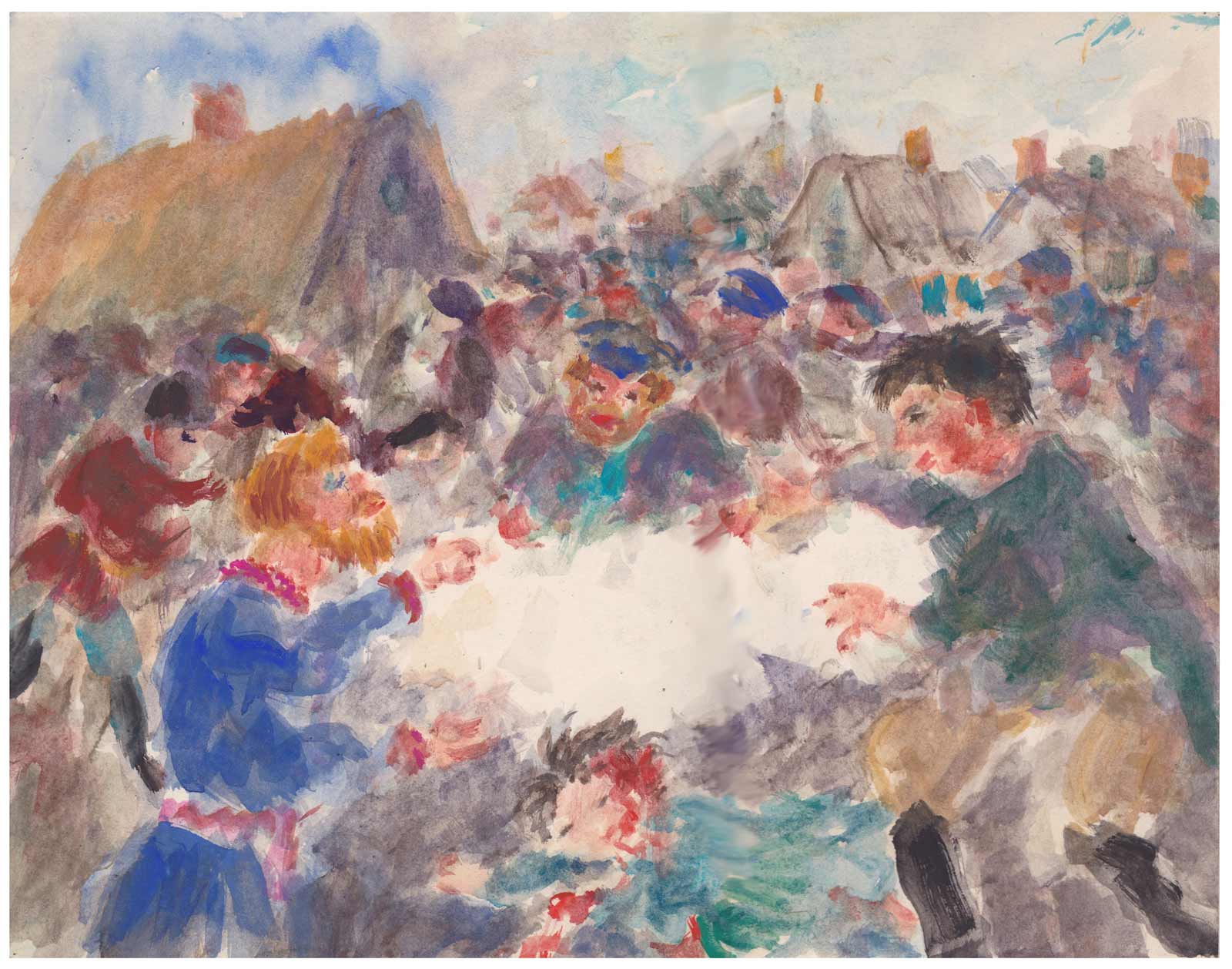“There, where we live, that is our country.”
—Motto of the Jewish Labor Bund
During his elder years, my great-grandfather, the post-Impressionist artist Sam Rothbort, tried to paint back into existence the murdered world of his shtetl childhood. Amid the hundreds of watercolors that he called Memory Paintings, one stood out. A girl silhouetted against some cottages, her dress the same color as the crepuscular sky above. A moment before, she’d hurled a rock through one now-shattered cottage window. On the painting’s margin, her boyfriend offers more rocks.
“Itka the Bundist, Breaking Windows,” Sam captioned the work.
I may have been fifteen, seventeen, or twenty when I saw the watercolor, in my great aunt’s sunbaked living room or my mother’s apartment; I don’t recall exactly. What sticks with me is the Old World awkwardness of the heroine’s name. Itka. I turned the Yiddish syllables on my tongue. And Bundist. What was that?
This question became a thread that led me to the Bund, a revolutionary society of which my mother’s Grandpa Sam had been a member, whose story was interwoven with the agonies and triumphs of Jews in Eastern Europe, and whose name has all but been erased.
Founded in 1897 in Vilna (Vilnius in modern-day Lithuania), and reaching its height in interwar Poland, the Bund was a sometimes-clandestine political party whose tenets were humane, socialist, secular, and defiantly Jewish. Bundists fought the Tsar, battled pogroms, educated shtetls, and ultimately helped lead the Warsaw Ghetto uprising. Though the Bund was largely obliterated by Nazi Germany and the Soviet Union, the group’s opposition to Zionism better explains their absence from current consciousness. Though the Bund celebrated Jews as a nation, they irreconcilably opposed the establishment of Israel as a separate Jewish homeland in Palestine. The diaspora was home, the Bund argued. Jews could never escape their problems by the dispossession of others. Instead, Bundists adhered to the doctrine of do’ikayt or “Hereness.” Jews had the right to live in freedom and dignity wherever it was they stood.
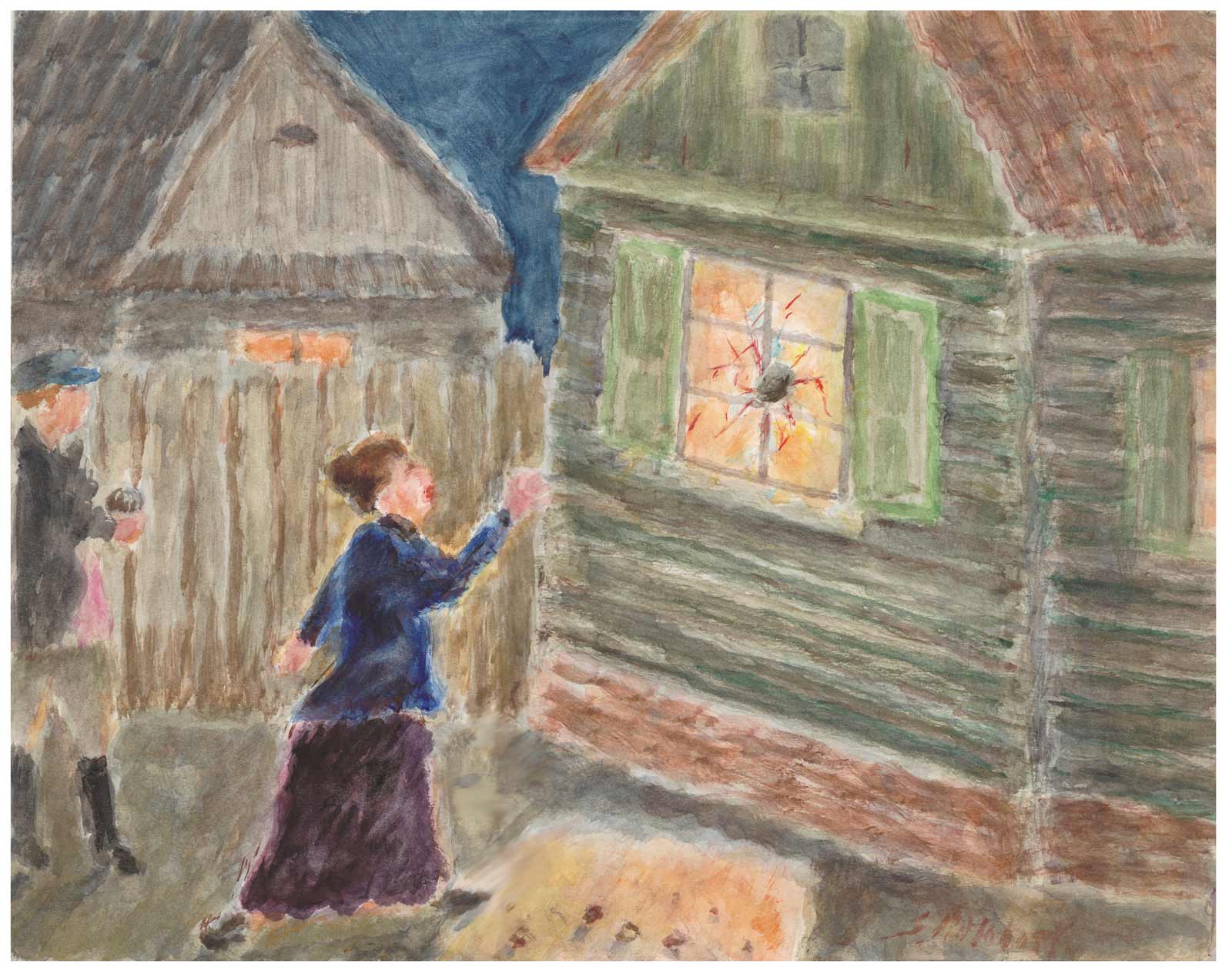
When the Bund is acknowledged at all today, it is often characterized as naive idealism whose concept of Hereness lost its argument to the Holocaust. But as I watch footage on social media of Israeli snipers’ bullets killing Palestinian protesters, I think that Bundism, with its Jewishness that was at once compassionate and hard as iron, was the movement that history proved right.
*
When thirteen Jews founded the Bund at a Vilna safe house, Sam Rothbort was a teenage orphan in Volkavisk, five days’ carriage ride away. His was a typical town in the Pale of Settlement, the impoverished Western provinces of the Russian Empire to which Jews were confined by Tsarist diktat. In the Pale, their lives were horribly marred by childhood military conscription, bans on employment, education,and landownership, and, most devastatingly, by state-sponsored pogroms. These, too, made their way into Sam’s memory paintings. In his watercolors, Russians slash feather-beds and burn houses: the whirl of goose down and fire stand in for the rape and murder taking place out of frame. Stylized violence alternates in these images with more quotidian humiliations. “Jew, take off your hat,” the Russians bark in the title of one watercolor. The Jews, submissively, comply.
Sam lost his mother at a young age in a cholera epidemic, and his sole education came from the synagogues where he used to sing; after his voice broke, he was forced to apprentice himself to a leather worker. While he wrote of his hometown’s beauty with a sensuous nostalgia, the photos of turn-of-the-century Volkavisk that survive in archives don’t support that rosy view. His childhood shtetl was a warren of wooden buildings and dirt streets, bisected by the Neimen river, and governed by a council of pious notables who beseeched the gentile authorities on behalf of poor Jews, whom they themselves often exploited.
Yiddish was the language of the shtetl, and the synagogue the town’s intellectual center. Hierarchy was all. Man above woman. Old above young. Life moved to the cycle of holidays, harvests, and Shabbat. Americans know this world best from the sentimentalized portrayal in Fiddler on the Roof, but the Bund had little patience for Tevye and his Tradition. In his memoir, The Stars Bear Witness, the Bundist Bernard Goldstein decried the shtetl’s “ignorance,” its “ancient religious superstitions.” Theirs were “the new ethics of the brotherhood of man, of mutual respect, and of the dignity of the individual.”
Months after the Bund’s founding, its agitators traveled to Volkavisk, where they spread the doctrine of labor rights among the young apprentices like Sam. Under the Bundists’ influence, the apprentices went on strike. The bosses brought in strikebreakers. Running battles spilled from the streets into the synagogue itself, where Bundists and the employers’ goons went after each other with clubs, in scenes Sam later reimagined in watercolors. Not that Sam stayed on the sidelines, simply looking on. “I took part in strikes and sabotage,” Sam later wrote. “I became a revolutionist.” The violence won the apprentices a radical new right: Saturday evenings off of work.
Advertisement
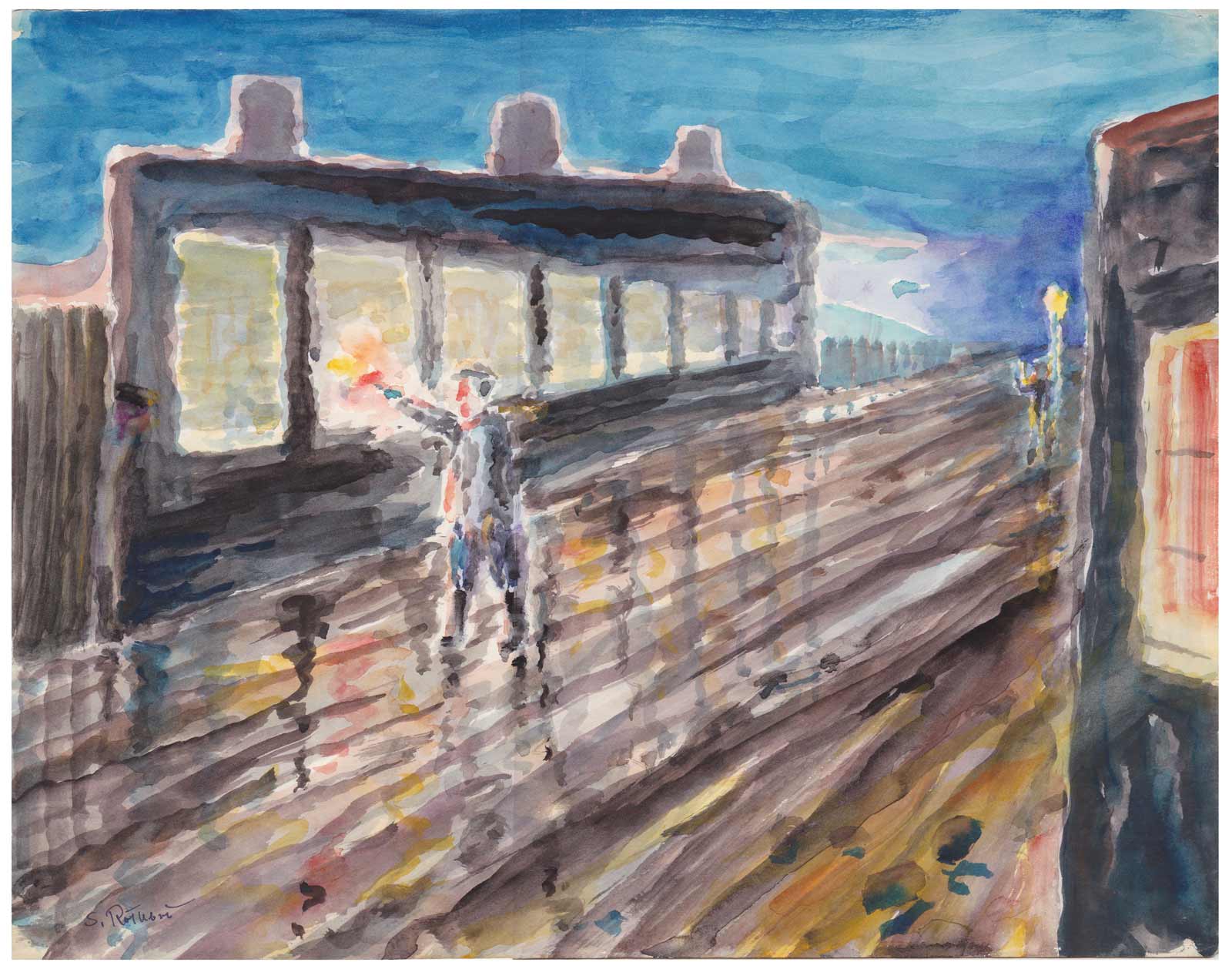
Buoyed by this success, Volkavisk’s Bund grew into a conspiracy of some eighty members, many recruited through the group’s Yiddish library. Anyone could read the Jules Verne translations, but promising visitors were loaned banned copies of Karl Marx’s works. Despite their status as an illegal political party, in summer they gathered beneath a red flag in Samokoven Forest and sang Di Shvue (The Oath), the Bundist anthem: “The red flag is high and wide. It waves in anger. It is red with blood.”
There, they plotted more ambitious exploits. They robbed a government alcohol monopoly in Izabelin. During strikes, they slashed phone lines, smashed up factories, beat scabs. They ambushed prison convoys, threw powdered tobacco (like improvised pepper spray) into the faces of the drivers and liberated their arrested comrades. They sawed through the cell bars of their friend Berl Dzhukin, and when the cops came looking for him at a comrade’s house he stole out, dressed as an old woman, into the open night.
In 1902, the year one of its members shot and wounded the hated governor of Vilna, the Bund was Russia’s only Jewish revolutionary party. No other group could compete with its illegal printing presses, its smuggling networks across the Pale of Settlement, its pogrom-fighting militias funded by contributions from the diaspora. At that time, Bundists made up a third of the prisoners in the tsar’s camps in Siberia, and the organization grew as its members traversed the Russian Empire, on the routes of forced exile and escape.
By 1904, the Bund had 35,000 members. That February, the Japanese fleet torpedoed Russian battleships in Manchuria, the tsar’s first humiliation in what would become the Russo-Japanese war. Strikes broke out, and with them retaliatory roundups. In Białystok (in what was later Poland), armed police massacred Jewish workers with impunity. Keen to avoid either a prison term in Siberia or death as cannon fodder in the tsar’s navy on the Yellow Sea, Sam fled the Russian Empire for the New World. When his boat docked at Ellis Island, my great-grandfather signed a declaration stating that he was not an anarchist and had no loyalty to the tsar. While the second is true, I have my doubts about the first.
He got out just in time. Foolish wars have a way of stirring sedition, and across the empire the tsar’s subjects decided his time was up. The Bund was one of many radical groups that swore to “drive the decrepit monster into the abyss.” When the revolution broke out in January, the Bund rose up across the Pale. Bundist brigades battled street to street with police and soldiers from Łódź in Poland to Odessa in southern Ukraine.
In 1905, Sam’s friends sent him a photo from the old country. In the manner of old studio portraits, the ten Bundists line up in front of a luxuriously painted backdrop, each wearing the black peasant blouse that was then the height of revolutionary chic. Chaim Shalke looked too young to grow a beard. Moshe Katriel stared off into space. Israel the Locksmith cocked his handsome head.
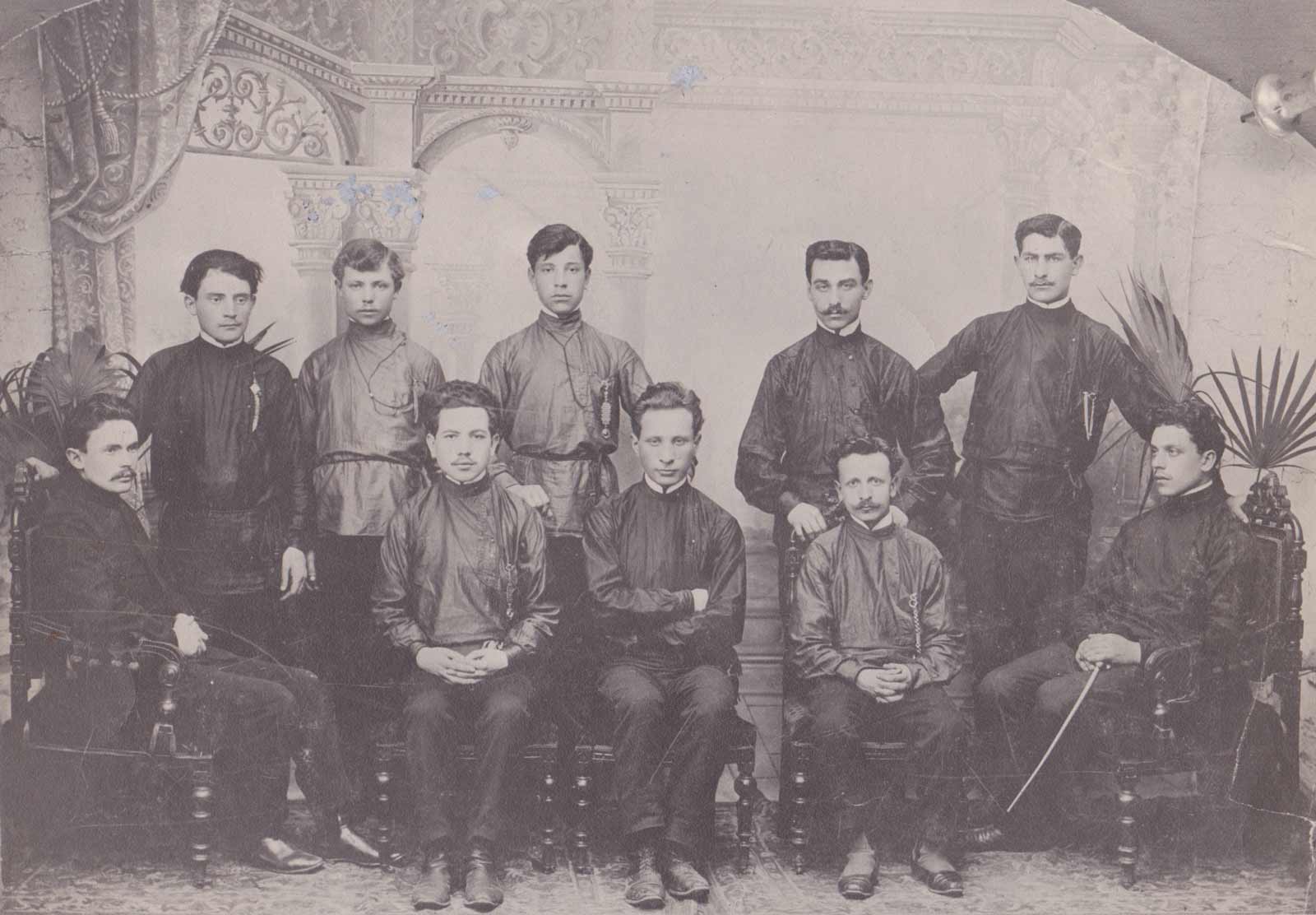
What happened to these wild ones? Did they even live out the year? After the revolution failed, a wave of pogroms broke out. Russians and Ukrainians—the Bund’s gentile brother workers—murdered hundreds of Jews. Another 125,000 fled to New York.
Like Sam, many of these refugees found their way into New York’s Jewish counterculture, on which Bundists were a leading influence. If you know the Vladeck Houses on the Lower East Side, you may be interested to learn that they were named for the Bundist revolutionary Baruch Charney Vladeck, once sentenced to Siberia in his youth many years before he got a job in Mayor Fiorello LaGuardia’s Housing Administration. How about Amalgamated Housing in the Bronx? It was sponsored by the Amalgamated Garment Workers’ Union, whose president, Sidney Hillman, got his start in labor activism as a Bundist organizer, leading the first May Day march through the streets of Kovno, Lithuania. A famous journalism award also carries Hillman’s name. Immigrant Bundists also led the Ladies’ Garment Workers’ Union and the Jewish Socialist Federation. They dominated the Workmen’s Circle, a secular Jewish mutual aid society that exists to this day, and whose banners still appear at protests against President Trump.
This milieu eased Sam’s integration into the New World. He joined the Workmen’s Circle and began each morning reading the red Yiddish of The Jewish Daily Forward. He became a vegetarian, a pacifist, and an artist.
Advertisement
*
With my great-grandfather safe in Brooklyn, we must turn elsewhere for the next chapter in Bundist history. Enter Bernard Goldstein, head of the Warsaw self-defense militia, and author of the memoirs Five Years in the Warsaw Ghetto: The Stars Bear Witness and Twenty Years with the Jewish Labor Bund.
Comrade Bernard Goldstein never knew Sam Rothbort. He was seven years younger, and in many ways Sam’s opposite. He was a party man, not an incorrigibly individualistic artist, and a street brawler, not a pacifist proto-hippie. Born in a village outside Warsaw, Goldstein joined the Bund in 1902, at the age of thirteen. By sixteen, he had survived one stint in jail; for a keepsake he had the scar from a prison guard’s saber on his chin. He spent the next decade escaping jails and organizing unions, then fought in the Revolution of 1905 that Sam so narrowly dodged. In 1915, during a stint in Siberia, he earned his place in legend. A commissioner condescended to Goldstein. Goldstein slammed a kerosene lamp over the commissioner’s head. The commissioner retaliated harshly. But like most Bundists, Goldstein had a compassionate streak. When the January Revolution broke out, the prisoners overthrew their guards, tied the commissioner to a tree, and presented him to Goldstein to execute. Goldstein refused. The revolution, he declared, must be humane.
Thence to Kiev, where he led a militia in 1917, and obtained a post on the municipal council. But the utopian bloom soon came off the revolutionary rose, as Russia descended into terror, repression, and civil war. “The day is not far off when we will see revolutionary tribunals in which the more kosher Bolsheviks will execute the more suspect; the circle of ‘kosher’ or ‘authentic’ socialists grows narrower,” Bundist leader Vladimir Medem wrote at the time. In 1921, the Bolsheviks dissolved the Bund, along with all other political parties. Disgusted, Goldstein returned to Warsaw. His group may have been dead in Russia, but it flowered again in the newly independent Poland.
In Warsaw, Goldstein moved among a Jewish working class, the memory of which has gradually disappeared among their upwardly mobile American descendants. These Jews were butchers, droshky drivers, seamstresses, prostitutes, and porters—the goods of the city strapped to their backs. These were tough, ill-educated, often violent men and women who drank with gangsters, settled scores with knives, and gave each other mob-style nicknames like Yankl Scar and Shloyme the Bone. Goldstein and his comrades organized these rough proletarians into Bundist unions, which by 1939 represented nearly 100,000 Jews. Not content with economic justice alone, the Bund created a parallel culture of progressive newspapers, theaters, libraries, and secular Yiddish schools. A Bundist could send their child to SKIF, a socialist scout group, then to the Bundist youth league, Tsukunft. Athletic young people built their physiques at the Bundist sports club, Morgenstern, while less fortunate slum kids were treated for tuberculosis in the humanistic, rural beauty of the Medem Sanatorium.
“We were a nation within a nation, formed and tested in a thousand years of struggle, cherishing our heritage and the rights that we had wrested from our unfriendly hosts,” Goldstein wrote. Archival photos bear testament to this world’s richness: Bella Shapiro, one of the Bund’s countless women leaders, addressing a May Day demonstration in Lublin in 1936; red flags fluttering with gold fringe and elegant Yiddish letters; unionized workers raising their fists; jaunty girl gymnasts in shorts, hearts pinned to their middy blouses; young men, boxing at the beach, grinning and tanned. These images of the bucolic wholesomeness are so poignant because we know how, for so many of them, the story ends.
The Bund always had plenty of enemies. Organized crime was one; Hasidic Jews angry at their anti-religious provocations were another. Then there were the factory owners, of course. And the card-carrying anti-Semites. The Bund’s enemies were not only on the right; Soviet-backed Communists attacked the Bund with campaigns of infiltration, sabotage, and murder. But while Bundists and Communists battled in the streets, the group’s main intellectual adversaries were the Zionists who saw their Eastern European home as exile from the promised land. Knowing that new nation-states were always created atop the blood of others, the Bund foresaw the fatal conflict involved in establishing Israel, which would lead to perpetual war with its neighbors and those it had dispossessed. “Zionism means a fight against the Arab masses,” wrote the Bundist intellectual Moishe Olgin in 1929. “They are to be deprived of their land, and the Arab working masses enslaved.”
The Bund also saw how Zionism could play into the hands of Polish racists. In 1937, the political party Oboz Zjednoczenia Narodowego (Camp of National Unity) called for the expulsion of 90 percent of the country’s Jews, whom it regarded as aliens. When Ze’ev Jabotinsky, the founder of Revisionist Zionism, visited Vilna that year, the Bund organized protests against the man they denounced as “the Spiritual Father of Jewish Fascism.” Whereas the OZN wanted to deport millions of Polish Jews, Jabotinsky called for their “evacuation”—a fine distinction the Bundists did not appreciate. “We are citizens with equal rights in this country!” one flier read. “We shall fight for work and for bread, for life and for rights here in Poland! We shall not permit charlatans… to speak in our name!”
Inspired by Hitler’s racial laws and the rising persecution of Jews in next-door Germany, and goaded by the local variety of Brownshirts, the Polish government turned to vicious anti-Semitism. Sometimes alongside the Polish Socialist Party, the Bund fought the public beatings, pogroms, and the segregated university seating arrangement known as “ghetto benches.” Polish fascists bombed the Bund’s headquarters. May Day demonstrations turned into street battles. “We struck back at Polish anti-Semites, believing that the Jews would retain their civil rights only if they showed that they could protect themselves,” wrote Goldstein. At the same time, they appealed for international intervention against fascism, “but our efforts were too puny to turn back the powerful forces that were pushing an indifferent and unresisting world toward precipice.” Though the Bund’s appeals abroad went unheeded, its resistance earned it the love and loyalty of the Jewish community at home. By 1938, the Bund was the most popular Jewish party in Poland.
In 1939, Goldstein reports in his memoir, police had just led a pogrom in Bretz, and Goldstein smuggled himself into the city. He finds a Jewish community paralyzed by the knowledge that, at any moment, the pogrom will explode again. In the deserted Jewish quarter, Goldstein meets a Polish comrade. As the two work out a battle plan, they see the glow of Sabbath candles in a window.
“I explained to Dąbrowski the meaning of the Sabbath candles… deep in somber thought, we both walked silently through the pogromized, empty streets… a Jewish and a Polish Socialist. Perhaps, I thought, hope resides in this, that we two, Dąbrowski and I, walk here together with a single purpose.”
I agree with Comrade Bernard, despite everything that happened next.
*
There is a myth that, before Israel, Jews did not fight. Even Hannah Arendt, making her controversial claim that Jewish leadership collaborated across the board with Nazis, falls into this error. The Bund, the elected leadership of Europe’s largest Jewish community, fought from the first day of the occupation to the last.
In September 1939, during the last-minute defense of Warsaw, half of the Jewish battalions were organized by the Bund. Only when Warsaw fell did the Bund’s leaders, Victor Alter and Henryk Erlich, flee east, seeking safety behind Soviet lines. Both were soon murdered by the NKVD.
Goldstein, meanwhile, re-entered Warsaw covertly to organize his old labor union friends into an underground. The Bund created youth groups, newspapers, illegal schools, and a courier service that transmitted news across occupied Poland; the latter’s operatives exchanged information at soup kitchens that the Bund set up as cover. Money came from New York-based organizations like the Jewish Labor Committee (founded by Vladeck), smuggled by Jewish girls pale enough to pass as Polish gentiles. Later, that money paid for hiding places and guns. After October 1940, when Nazis began herding Warsaw’s Jews into the Ghetto, the Bund organized the teeming tenements into committees dedicated to cultural, as well as physical, survival.
Given the privations and repressions, it is not surprising that so few of the ghetto’s traumatized inhabitants could imagine taking up arms. But it says something about the endurance of sectarian political divisions and the tragic difficulty of overcoming them that the few hundred people willing to fight could not unite in the face of their inevitable liquidation. On July 23, 1942, after mass transports began, the Bund finally joined with Communists and leftwing Zionists to form the Jewish Combat Organization (ZOB). But in their memoirs, surviving Bundists would ridicule the Ghetto’s other armed group, the right-wing Jewish Military Union (ZZW), because it was led by a Revisionist Zionist. Some grudges never fade.
The Bund’s long relationship with Polish socialists allowed them to breach the ghetto walls, sneak in Polish resistance soldiers, and provide the world with some of the first accounts of the Nazi genocide, through the testimonies of Zalman Freidrych and Jan Karski. Through these networks, news filtered out, and weapons flowed in. In April 1943, three months after the first brief battle of the Warsaw Ghetto Uprising, one final arms shipment smuggled by Bundists got through the Ghetto walls.
How many Nazi troops died in that doomed revolt is still disputed. Three hundred, according to Bundist Marek Edelman, who assumed command of the ZOB, after its first leader committed suicide to avoid surrender. Sixteen, claimed the SS commander Jürgen Stroop, who had every reason to suppress the true figures. What is known is that it took the most feared military force in Europe three weeks to subdue 750 starving, inadequately-armed captives. Even then, the ghetto fell not to fighting, but to fires, set by German flamethrowers and incendiary bombs. Some 13,000 Jews died in the rebellion. In London, Artur Ziegelboim, the Bund’s representative in the Polish parliament in exile, took poison in a futile attempt to rouse the world from its indifference. The words of his suicide note read: “I love you all. Long live the Bund.”
On May 10, with the Ghetto reduced to a smoldering ash-heap, a band of fighters led by Edelman, the Bundist Abrasha Blum, and the ZOB’s only female leader, the labor Zionist Zivia Lubetkin, escaped through the sewers. On the Aryan side of the wall, Goldstein wrote, “a large crowd watched incredulously as human skeletons with submachine guns strapped around their necks crawled [out] one by one… The look in their leaden eyes assured the crowd that they would not hesitate to fire.”
Shortly after his escape, the Gestapo killed Blum. Lubetkin and Edelman fought as partisans until Poland’s liberation. Lubetkin moved to Israel in 1946. She spent the rest of her life in a kibbutz for former Jewish partisans, built on the ruins of an Arab village whose inhabitants were driven out by the Haganah, a militia that was later absorbed into the Israel Defense Forces, a day before the outbreak of the 1948 Arab-Israeli war. Edelman stayed in Poland. As an old man, he took part in the Solidarity movement that led in 1989 to the peaceful end of Poland’s communist dictatorship. When he died, in 2009, mourners sang the Bundist anthem over his coffin. He received no honors from the Jewish state.
*
Once, thousands of Jewish communities were laid like lace across the map of Eastern Europe. They had made the “here” in the Bundist concept of Hereness. By 1945, this world had vanished, along with its inhabitants. Gone was Bernard Goldstein’s Warsaw. Gone was Sam’s Volkavisk.
On January 16, 1945, Goldstein crawled from one of the bunkers where he’d spent most of the last two years virtually entombed and found his city reduced to rubble. Ninety percent of Polish Jews had been murdered, and most Poles treated the rest with a feverish sort of racism. Meanwhile, the Soviet occupiers busied themselves hunting down anyone who’d worked with the Polish resistance. “This was not the liberation for which I had waited five long, heartbreaking years,” Goldstein wrote. “Under the Nazis we had lost the lives of millions upon millions of men, women and children… But now we had lost the faith that… after the nightmare of helplessness in the murderers’ grasp, would come a new day of justice, human decency and brotherhood.” Using phony papers, Goldstein smuggled himself to a displaced persons camp in Czechoslovakia, then made his way to the United States, where he devoted the rest of his life to two volumes of memoirs in tribute to his lost comrades. He died in 1959 and is buried in New York. Other Bundists tried to rebuild the organization, until the following summer when, stirred by an anti-Semitic blood libel, Poles murdered forty-two Jews in Kielce, in southern Poland. In the next three months, 95,000 of Poland’s surviving Jews fled, via a Zionist-led clandestine network, to displaced persons camps in American-occupied Europe.
What pogroms could not accomplish, Stalinism did. “Many Jews who would have clung stubbornly to their homes despite anti-Semitism felt that they had to flee communism,” wrote Goldstein. Poland’s Soviet-backed government unleashed a campaign of mass arrests, surveillance and execution against every credible alternative to its rule. Within three years of liberation, it had liquidated the Bund.
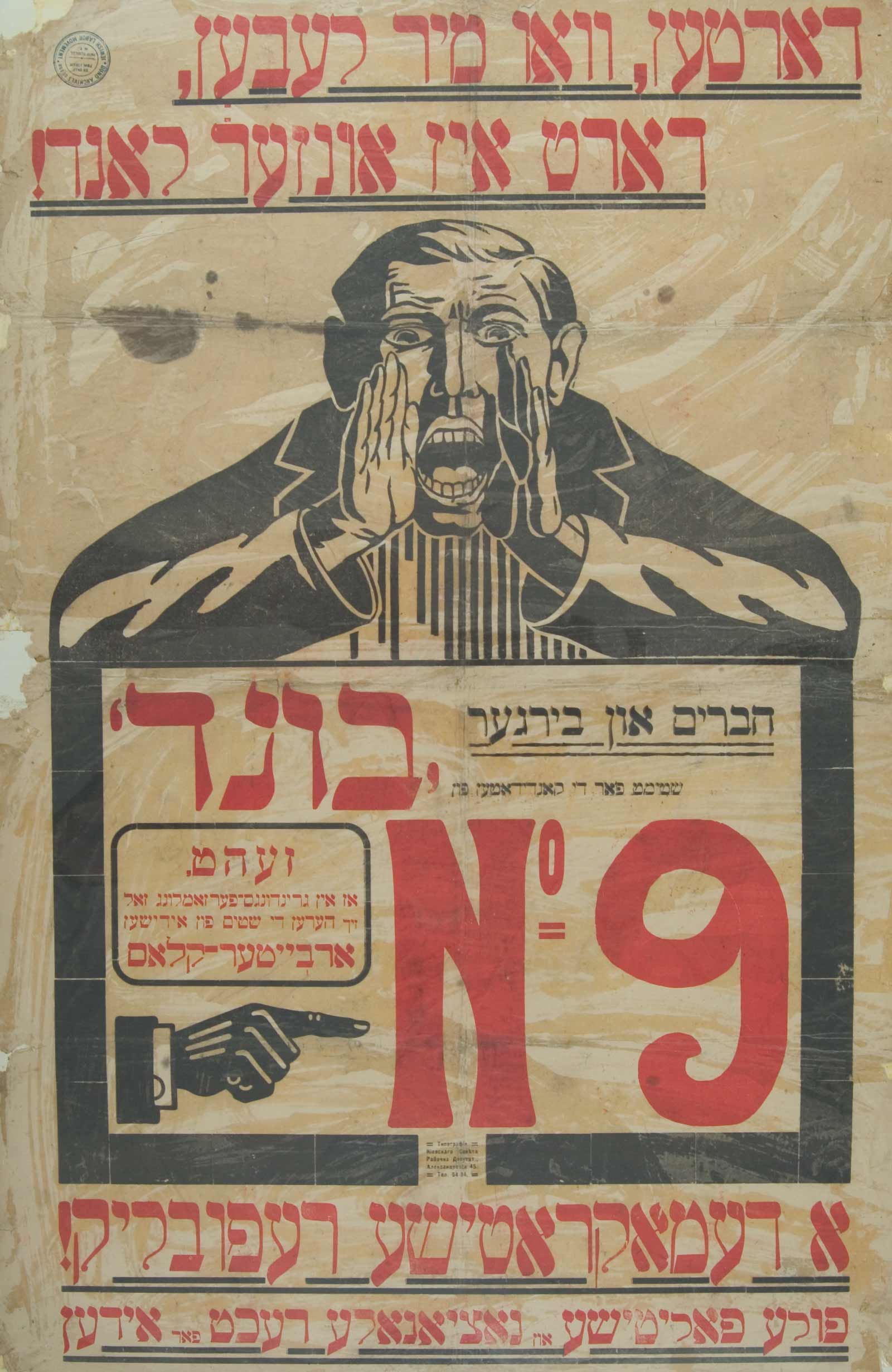
Like Goldstein, other Bundists scattered. The unlucky went to squalid DP camps, which were often dominated by Zionists and where they alleged they were beaten and denied ration cards for resisting a draft imposed by the Haganah. Some gave up the struggle against Zionism and took the Haganah’s smuggling boats to Palestine. Those who were lucky enough to get foreign visas ended up in to refugee communities in Shanghai and Johannesburg, Paris and Montevideo. The Bund reconstituted itself as an international organization in 1947, with its base then in New York. That year, it called for an independent Palestine that would provide equality and self-government for both Jews and Arabs, for the resettlement of Jewish refugees in all free countries, and for Zionists to “renounce the goal of an independent Jewish state.” Immediately after the 1948 Arab-Israeli war, the Bund demanded the right of return for Palestinian refugees that had been expelled by the IDF.
Such universalist humanism found fewer adherents after the Shoah. “Deeply grieved and shaken by the murder of six million of their brethren, the masses of the Jewish people became enveloped by strong nationalist tendencies, which… fanned by skillful Zionist propaganda, caused among the Jews a psychosis of Zionist and Messianistic illusions,” the Bund’s coordinating committee wrote in 1948. After all, had the civilized West not spent the preceding fifteen years slamming its doors shut to Jewish refugees on the pretext that they were not real Europeans? Would not Iraq, a few years later, force out more than 100,000 Jewish citizens on the pretext that they were Zionists?
Perhaps a group as innately Eastern European as the Bund never could have flourished on foreign soil. On the face of it, the Bund had little to offer Mizrahi and Sephardic Jews. In Tel Aviv, its tiny party organization could not even afford the funds required to get on the ballot. In capitalist, democratic America, the Bund seemed a relic, even among the US-based organizations that previous generations of Bundists had founded, and Bundist immigrants’ alienation only grew when they insisted on defining Jewish identity by a Yiddish that their own children had abandoned. While Bundists continued to pop up at later historical interstices—marching for civil rights in the Fifties, hosting a lecture by the Palestinian-American academic Edward Said in the 1970s—the postwar period’s combination of the Soviet gulag, Western assimilation, and Israeli hegemony eventually squeezed the Bund into irrelevance. By the 1980s, nothing was left but a dwindling number of old people with faded red banners and a dead language, ghosts in a legion hall for Veterans of Lost Causes.
The Bund’s Worldwide Organizing Committee dissolved in 2003, but several affiliated groups survived. In August 2018, when someone pasted a swastika on a billboard in Melbourne, Australia, it was immediately covered by a sticker for the organization my great-grandfather had joined in 1898.
*
Though he died before I was born, I grew up surrounded by reminders of my great-grandfather. It was not just the thousands of his paintings, sculptures, watercolors, and mosaics that filled my great-aunt’s house in Sheepshead Bay, but the very presence of Grandpa Sam himself, as if his personality had been too vivid to allow him to be rendered a ghost. And from my great-aunt and my mother, I knew his story.
Sam worked in Brooklyn, as a decorator and a watchman for wealthy homes. During late nights, he carved small figures out of wood to pass the time. His boss encouraged his talent. He quit his jobs. From then on, he would be nothing but an artist. He taught himself to paint, gluttonously, selfishly, and exhibited throughout the 1920s. At the height of the Depression, he moved to rural Long Island to open a no-kill egg farm (he was a moral vegetarian before his time). Unsurprisingly, it went bankrupt.
He moved back to Sheepshead Bay with his wife Rose, who was from Luna Voda, near Białystock, and to whose face I can trace back some of my own features. There, in Brooklyn, no longer able to afford paints, he learned to carve sculptures from old doors and fenceposts. “Without art, you’re dead!” he pronounced later. While he had galleries, he spread his paintings on his front lawn every morning for decades, and called it “The Rothbort Home Museum of Direct Art.” He self-published a book about his sculptures, Out of Wood and Stone, filled with reminiscences of an idealized Volkavisk. In his memories, the shtetl loomed like a Chagall painting, a wonderland of old goats and heavenly love thrills and prophets, all rendered universal rather than tribal. Like Rembrandt, he painted himself in a thousand disguises. These oil paints that he smeared over his face probably caused the skin cancer that killed him in 1971. Even while dying, he made his nurses laugh.
My mother had learned to paint at his side, and so knew his aphorisms well. To her, he was forever Grandpa Sam, the self-taught artist, the trickster who blew fire and hung upside down on a chin-up bar into his eighties, who believed all men were brothers—though artists were a cut above. Who read Shakespeare in Yiddish. Whom she never saw visit a synagogue, though his own father had studied the Talmud.
I knew Sam Rothbort was a rebel, of course, but I knew only vaguely what that had meant. Perhaps he did associate with “revolutionists” in the old world, but my awareness of that word’s implications paled beneath all I knew about my mother’s beloved grandfather. Photos showed him as the charming old joker with a nimbus of white hair, an axe-like nose, a smile full of earthy humanity. He was not a party man in America, either Democrat or Communist. He confined his political activity to writing letters to President Eisenhower, which he was convinced hastened the end of the Korean War.
So, when I first saw that word “Bundist” among his painting titles, I gave it a quick Google and moved on. Only later, after my own work of reporting, from Gaza and elsewhere, did my research turn into a fixation. I needed to know about the Bund, and not just because they were my great-grandfather’s comrades, but because I wanted to make visible again a group that had almost vanished, though it was so just and so right. I acquired the few books on the Bund that are still in print, spent days squinting at dusty pamphlets in the New York Public Library, at photos put out by the YIVO Institute for Jewish Research and the archives of Bundist newsletters on the web.
Finally, I hired a Yiddish translator to unlock for me a chapter on the Bund in Volkavisk’s Yizkor Book (Yizkor books were oral histories compiled after World War II to record something of the lives of the countless murdered from the shtetls of Eastern Europe). When the translator returned the pages, there sat Sam’s name, as one of the book’s narrators, right above a photo of a group of girls, including the famous Itka, at first sight unfamiliar with her sleek bob. This was proof: Sam had taken part in an armed resistance movement, something I had never imagined him capable of. What change of heart or evolution in his thinking took him from that commitment to a pacifism so intense he would not kill a chicken, I can only guess at.
But as far as he had traveled from Volkavisk, I came to see the traces of Bundism that he kept within. His benign lawlessness. His contempt for money. The welcome he gave to my Puerto Rican father and my Korean aunt. His lack of ties to Israel. The sculpture he made of a worker’s fist, clenched Communist-style—though he slyly mocked Communism in the caption. His bohemian humanism, big enough to take in the world.
*
In Israel, the Bund has been either ignored or belittled. “[They] are perceived as individuals who stubbornly clung to an unrealistic solution for Jews’ persecution in Europe, with the ‘right’ solution being the one offered by the Zionists—immigration to Palestine,” Israeli human rights activist Elizabeth Tsurkov told me. Zionist ideologues have a self-serving motive for framing it this way. For Jews, there could be only two choices: march like a sheep to the gas chamber, or become a brave Israeli, bravely suppressing Arabs. Diasporic weakness is the necessary foil for sabra strength.
I visited Israel and its Occupied Territories once, as a reporter. I marveled at the beauty of Jerusalem, saw settlers hurling rocks in Hebron, and in Gaza listened to the shells landing around us. Despite Israel’s achievements, Jewish ethno-nationalism is a poison like all ethno-nationalisms and, as they all do, it has continued to reap a harvest of repression and death. The only way out is a solidarity that cuts across religion and race, one as deep as that felt by Dabrowski and Goldstein when they walked the pogrom-stilled streets of Bretz that Sabbath night.
I return to do’ikayt, Hereness: a doctrine created by the godless Jews of the diaspora, written with mongrel words in Hebrew letters, then spread by itinerant troublemakers carrying forged passports, whose fundamental demand was the right to stay. What does Hereness mean in our age of mass migration? An attempt, I believe, to find the self in exile, to square homeland with the freedom to leave.
Sam made another painting, titled Without Passport. It shows two men and a woman in a moonlit forest, dragged off by the tsarist police. They were most likely Jews who lacked the internal passport that would allow them to travel outside the Pale of Settlement. But they had tried, anyway. Was this a betrayal of “Hereness”? Or was the “here” within them, in their act of illicit movement? Did their defiance taste like home?
I like to think that, later that night, Sam and his comrades sawed through the bars of the trio’s jail cell window. They would have shimmied out, the couple perhaps pausing for a kiss amid the frigid stillness of the forest, and then going on, past a border blurred by snow fall, going wherever they wanted to go.


